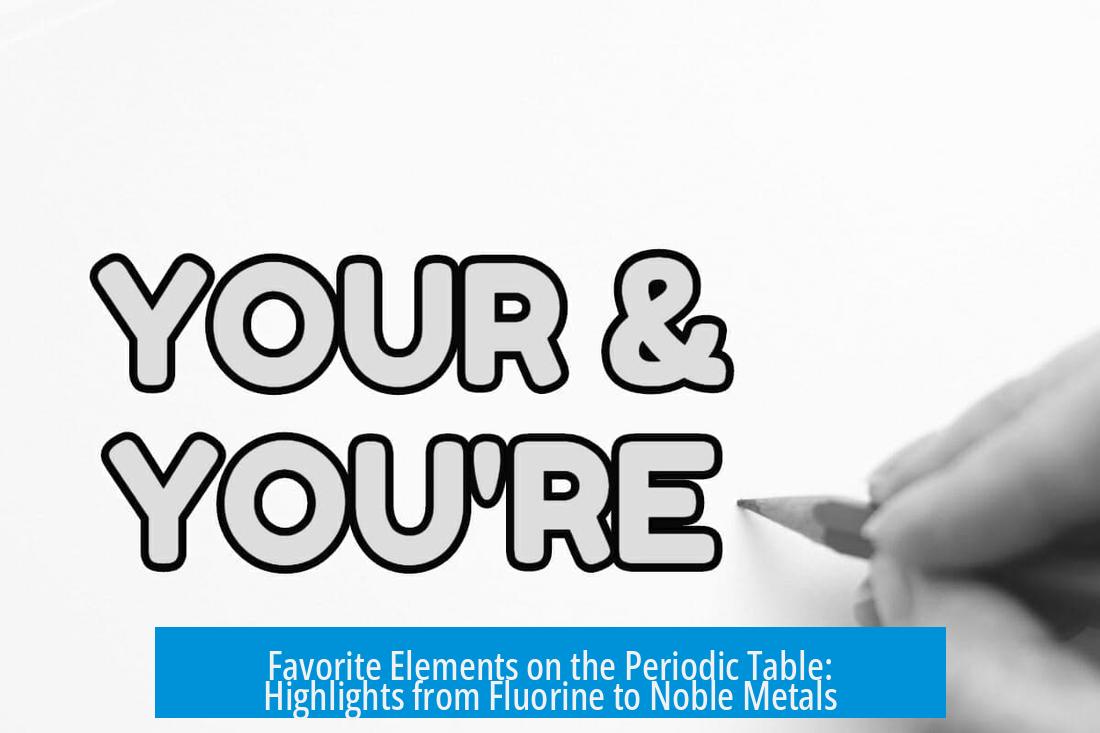What Is Your Favourite Element on the Periodic Table?
The choice of a favourite element on the periodic table depends on diverse factors—chemical properties, physical traits, applications, or even personal connections. Elements like fluorine and carbon frequently rank high due to their unique behaviors and essential roles in chemistry and life. Each element captivates chemists and enthusiasts for various scientific and emotional reasons.
Fluorine: The Unpredictable Flame
Fluorine is notable for sparking strong reactions, both in chemistry and among scientists. Known as the most electronegative element, fluorine reacts vigorously with many substances. As Professor Manfred Schlosser states, fluorine “leaves nobody indifferent.”
It is a difficult element to handle but highly valuable in pharmaceuticals and materials science. Fluorine-containing compounds often have unique properties, influencing molecular behavior unpredictably, making fluorine a source of continual surprise.
Carbon: The Backbone of Life and Chemistry
Carbon often claims the top spot among favourite elements. It forms the basis of all known life and organic chemistry. Organic chemists especially appreciate carbon for its versatility in forming chains, rings, and complex structures.
Carbon’s ability to create stable bonds with many elements and itself leads to an almost infinite variety of compounds. From diamonds and graphite to the hydrocarbons powering engines, carbon dominates biological systems and industrial chemistry.
Carbon’s Key Attributes:
- Six electrons, allowing multiple valence bonds
- Forms strong covalent bonds
- Basis of all organic molecules
- Essential for fuel, drugs, and materials
Hydrogen: The First and Simplest Element
Hydrogen is the simplest element, consisting of a single proton and electron. It is fundamental in chemistry and the universe, being the primary building block for stars and water.
Hydrogen’s mathematical simplicity and its role as the first element make it appealing for theoretical and practical reasons. Its applications expand into fuel technologies and as a clean energy source.
Nitrogen: Versatile and Vital
Nitrogen accounts for 78% of Earth’s atmosphere and is central to life’s molecular machinery, found in DNA and proteins. It is also found in explosives, showcasing a dual role in both life sciences and industry.
Its variability in oxidation states and presence in a wide array of compounds adds to its fascination. Many chemists admire nitrogen’s broad functionality.
Tungsten: Physical Mastery in the Metals
Tungsten captivates due to its extraordinary physical properties. It has the highest melting point of all metals and a remarkable density. A small tungsten cube clearly feels heavy, demonstrating its unique mass-to-size ratio.
It is prized for industrial uses where hardness and heat resistance are crucial. Students often hold tungsten and aluminum to feel the contrast in metal densities firsthand, deepening appreciation for its unique nature.
Boron: The Electron-Poor Oddity
Boron is unique as the only stable atom with six valence electrons instead of the usual eight. This electron deficiency drives novel chemical behavior, making boron compounds useful in organic synthesis and materials science.
Its role in hydroboration reactions, converting alkenes into alcohols, highlights its synthetic significance. Boron’s peculiar electronic configuration sets it apart.
The Lanthanoids and Exotic Metals
The lanthanoids intrigue with complex electron arrangements and specialized applications, particularly in magnets and electronics. Dysprosium stands out due to its name and magnetic properties.
Other rare earths like cerium and ytterbium exhibit unique nuclear magnetic resonance (NMR) characteristics, useful in spectroscopy and research.
Bromine and Mercury: Liquids That Impress
Bromine is the only nonmetallic element liquid at room temperature, emitting a heavy, reddish vapor, known for its toxicity and striking appearance.
Mercury also liquefies at room temperature and has fascinated observers for centuries due to its reflective, metallic liquid form. Both elements are valued for their distinct physical states among the elements.
Transition and Noble Metals With Special Appeal
Elements like palladium, silver, iridium, and gold are favoured for their chemical behavior, conductivity, or status as noble metals resistant to corrosion.
Iridium, for example, is noted as the “most noble metal,” prized for its stability. Gold’s historical and economic significance also enhances its appeal.
Other Fascinating Choices
- Chlorine: Congenial for its reactivity and essential role in disinfectants.
- Sulfur: Recognized for its bright yellow color and presence in important biological molecules.
- Lead: Known for toxicity and historical utility in paints and cosmetics.
- Titanium: Valued for strength and corrosion resistance despite purification challenges.
- Cesium: Noted for its reactivity and applications in atomic clocks.
- Thallium: Intriguing due to its toxicity and numerological significance to some.
Disliked or Less Popular Elements
Scandium is an example of an element that receives negativity among some chemists, possibly due to limited practical applications or perceived dullness.
Summary of Key Points
- Fluorine: Reactivity and unpredictability captivate.
- Carbon: Fundamental to life and organic chemistry.
- Hydrogen and Nitrogen: Simplicity and essential biological roles.
- Tungsten: Physical properties like density and hardness.
- Boron and Lanthanoids: Unique electronic and magnetic traits.
- Liquid elements: Bromine and mercury impress with states at room temperature.
- Noble and transition metals: Stability, conductivity, and color variations attract interest.
Personal preferences often balance scientific intrigue, practical importance, physical properties, and even emotional or cultural influences. The periodic table offers elements that resonate differently with each person, reflecting both diversity and complexity in the world of chemistry.





Leave a Comment